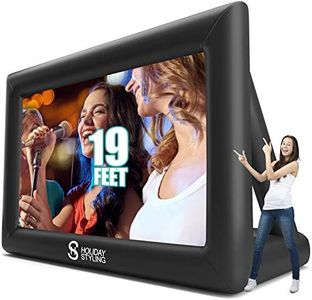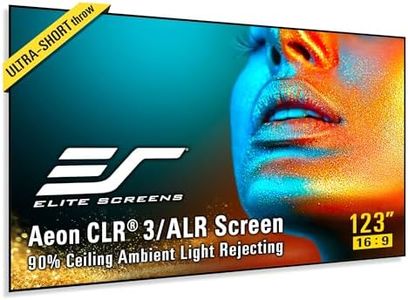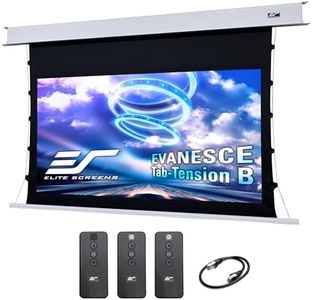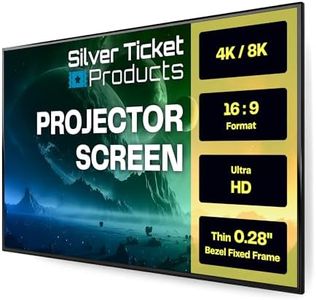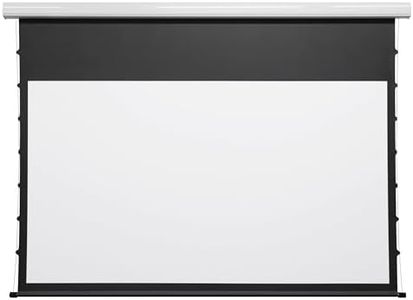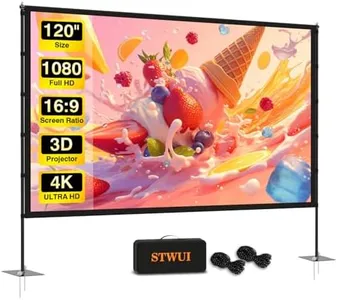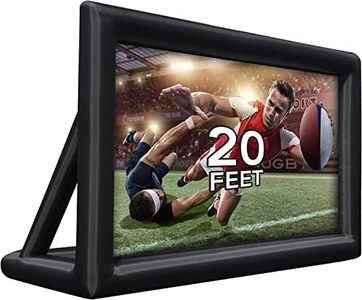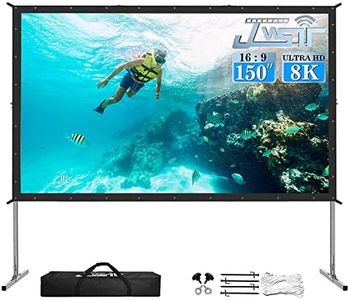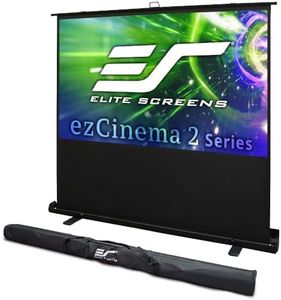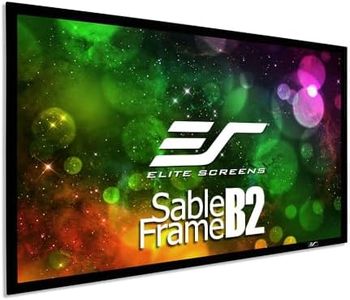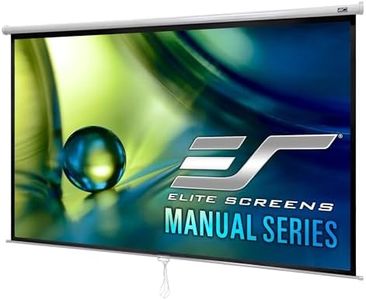10 Best Projector Screens 2025 in the United States
Our technology thoroughly searches through the online shopping world, reviewing hundreds of sites. We then process and analyze this information, updating in real-time to bring you the latest top-rated products. This way, you always get the best and most current options available.

Our Top Picks
Winner
Elite Screens Aeon CLR3 123" UST ALR Projector Screen, 16:9 4K Ultra HD, 90% Ceiling Light Rejecting, Edge-Free Fixed Frame, Grey Screen for Indoor Home Theater & Movies – AR123H-CLR3
Most important from
243 reviews
The Elite Screens Aeon CLR3 123" projector screen is designed for indoor home theater use, particularly excelling with Ultra-short Throw (UST) projectors. It offers a large 123-inch diagonal screen size with a 16:9 aspect ratio, making it great for movies and immersive viewing experiences.
The state-of-the-art CLR 3 material is a standout feature as it rejects 90% of overhead light and enhances contrast significantly compared to standard screens, which is beneficial in rooms with ambient light. The screen also supports 4K/8K Ultra HD and Active 3D, ensuring high-quality visuals. With a 170° viewing angle, it allows a wide range of seating positions without compromising image quality.
The edge-free design mimics a flat panel TV, providing a sleek, modern look that maximizes the viewing area. However, it is compatible only with UST projectors, which may limit its versatility. The screen is relatively lightweight at 24.8 pounds and easy to mount on walls. Elite Screens also offers a substantial warranty and lifetime tech support, which adds value and peace of mind for the user. On the downside, it may not be ideal for users who do not have a UST projector, and its premium features come at a higher price point.
Most important from
243 reviews
Elite Screens Evanesce Tab-Tension B, 120-inch 16:9, 4K / 8K HD, Recessed in-Ceiling Electric Tab Tensioned Projector Screen, Matte White Projection Screen Surface Programmed Remote Kit, ETB120HW3-E8
Most important from
187 reviews
The Elite Screens Evanesce Tab-Tension B is a 120-inch projector screen designed for high-definition viewing experiences. With a 16:9 aspect ratio, it's perfect for home theaters or professional presentations. The CineWhite material with a 1.1 gain ensures bright and clear imagery, supporting 4K and 8K HD projections as well as active 3D. Its 160-degree viewing angle allows a wide audience to enjoy the content without losing picture quality, and the tab-tension system maintains a perfectly flat surface for an undistorted viewing experience.
The screen can be easily cleaned with soap and water, making maintenance straightforward. Additionally, the recessed in-ceiling mount keeps the setup discreet and space-efficient. Included in the package are an installation kit, several remote controls, and a wall box controller with an IR sensor, which adds flexibility and convenience in controlling the screen. The RF remote feature helps reduce electrical interference and allows multiple screens to be managed easily.
Weighing 56.3 pounds, it may require additional support during installation. Furthermore, while it's suitable for both standard and short throw projectors, its premium features come at a higher price point, which might be a consideration for budget-conscious users. Backed by a 2-3 year warranty and lifetime tech support from Elite Screens, it's a reliable choice for those seeking a high-quality, long-term solution.
Most important from
187 reviews
Projector Screen Elite Screens Spectrum, 150-INCH Diag 16:9, Motorized Projection Screen Movie Home Theater 4K/8K Ultra HD Ready, ELECTRIC150H2
Most important from
178 reviews
The Elite Screens Spectrum 150-inch projector screen is an excellent choice for home theater enthusiasts looking for a motorized option. With its large viewing area and a 16:9 aspect ratio, it’s perfect for watching movies or sports in a cinematic setting. The MaxWhite 2 material offers a 1.1 gain, which helps enhance image brightness, and it’s compatible with 4K and 8K projectors, making it versatile for various viewing needs.
One of the standout features is the easy installation process. It comes fully assembled and includes an installation kit, so you can quickly mount it on your wall or ceiling. The motorized function allows for convenient operation with included infrared and radio frequency remotes, plus a wall box controller with a built-in IR sensor. This can be especially helpful if you want to adjust the screen's position without getting up.
The 180-degree viewing angle ensures that everyone in the room can enjoy a clear picture, and the screen material is easy to clean, maintaining its appearance over time. Additionally, the 2-year/3-year warranty and lifetime tech support provide peace of mind for buyers. The 30.3-pound weight may require careful installation to ensure it’s securely mounted. Some may find the price to be on the higher side compared to manual screens, but the motorized convenience and quality may justify the investment for serious movie watchers.
Most important from
178 reviews
Buying Guide for the Best Projector Screens
Choosing the right projector screen can significantly enhance your viewing experience, whether it's for home theater, business presentations, or educational purposes. The key is to understand the different specifications and how they align with your specific needs. Here are some important factors to consider when selecting a projector screen.FAQ
Most Popular Categories Right Now
